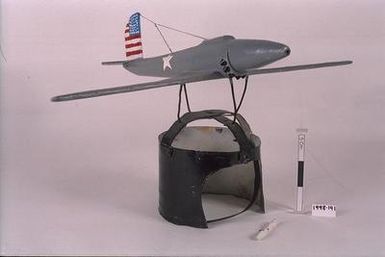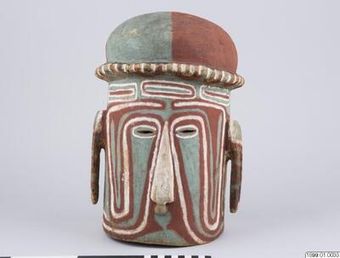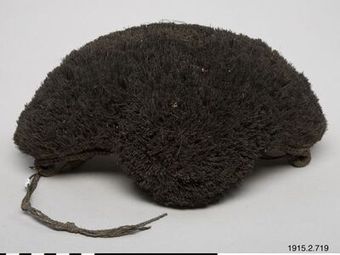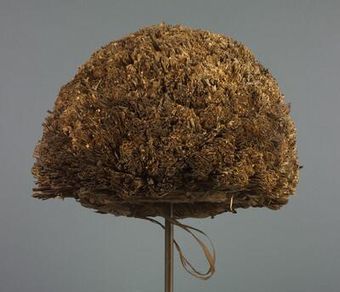Connect with Horniman Museum and Gardens
Contact this content partner to get more information about this item.
helmet masks
- Description:
- This dance headdress comes from the Torres Strait Islands, a group of more than 200 islands in the Torres Strait, which separates Australia and Papua New Guinea. Ceremonial dancing is an important part of Islander culture. Dances are preformed at festivals, celebrations, community events, weddings and historical occasions. Each clan has its own dances and costumes. The creation of costumes and masks for the dances are an important arts tradition in the Torres Strait. The Torres Strait Islanders continually adapt and incorporate change into their culture. New dances are created to mark important moments in Islanders’ history. This headdress was made for the Aeroplane Dance, which records the Islanders’ involvement in World War Two and the effect the war had on the islands. The headdress is made from metal petrol containers and wooden aeroplanes, which recall the Allied forces flying over the islands. The Torres Strait Islands were a strategic point for Australian defence and many Islanders enlisted in the armed forces. The Aeroplane Dance was performed on the Torres Strait Islands directly after the war. The dance was revived in 2003 when it was performed as part of an ANZAC Day ceremony (25 April) to commemorate the Australians and New Zealanders lost during wartime. The headdresses made by Islanders are part of a continuing tradition. Artists still make props for dances using modern materials such as plastic in a traditional method. The aeroplane headdress is displayed in the Centenary Gallery next to a crocodile headdress, collected in 1903, which was used for the Death Dance. The aeroplane headdress marks how the Torres Strait Islanders have incorporated new influences into a traditional practice. A metal helmet mask with a rubber strap, surmounted by a wooden aeroplane superstructure, which was used to recount stories or events dramatised in dances. The propellor is unattached.
- Format:
- image
- Collections:
- Horniman Museum and Gardens
- Content partner:
- Horniman Museum and Gardens
- Availability:
- Not specified
-
Copyright status: All rights reservedFind out more about what you are able to do with this itemThis item is all rights reserved, with means you'll have to get permission from Horniman Museum and Gardens before using it. For more information, please see our use and reuse page.More informationHorniman Museum and Gardens has this to say about the rights status of this item:
http://rightsstatements.org/vocab/InC/1.0/
What can I do with this item?Non-infringing useNZ copyright law does not prevent every use of a copyright work, and this item may be hosted by an international institute or organisation. You should consider what you can and cannot do with a copyright work.No sharingYou may not copy and/or share this item with others without further permission. This includes posting it on your blog, using it in a presentation, or any other public use.No modifyingYou are not allowed to adapt or remix this item into any other works.No commercial useYou may not use this item commercially.
Welcome and warm Pasifik greetings
The information on this site has been gathered from our content partners.
The names, terms, and labels that we present on the site may contain images or voices of deceased persons and may also reflect the bias, norms, and perspective of the period of time in which they were created. We accept that these may not be appropriate today.
If you have any concerns or questions about an item, please contact us.



